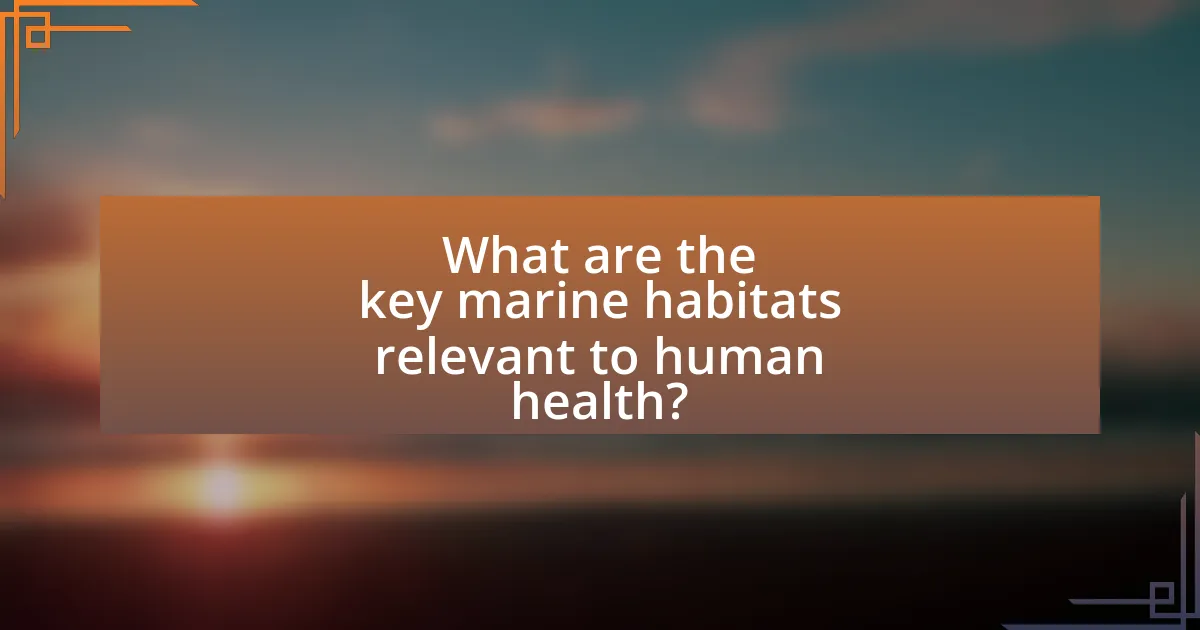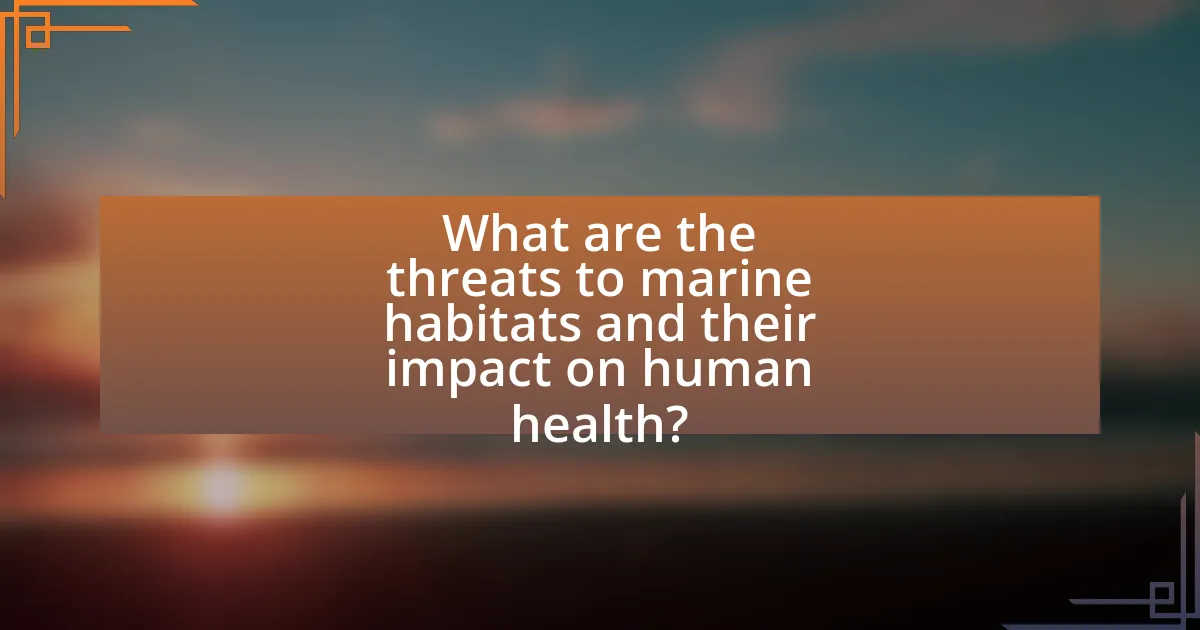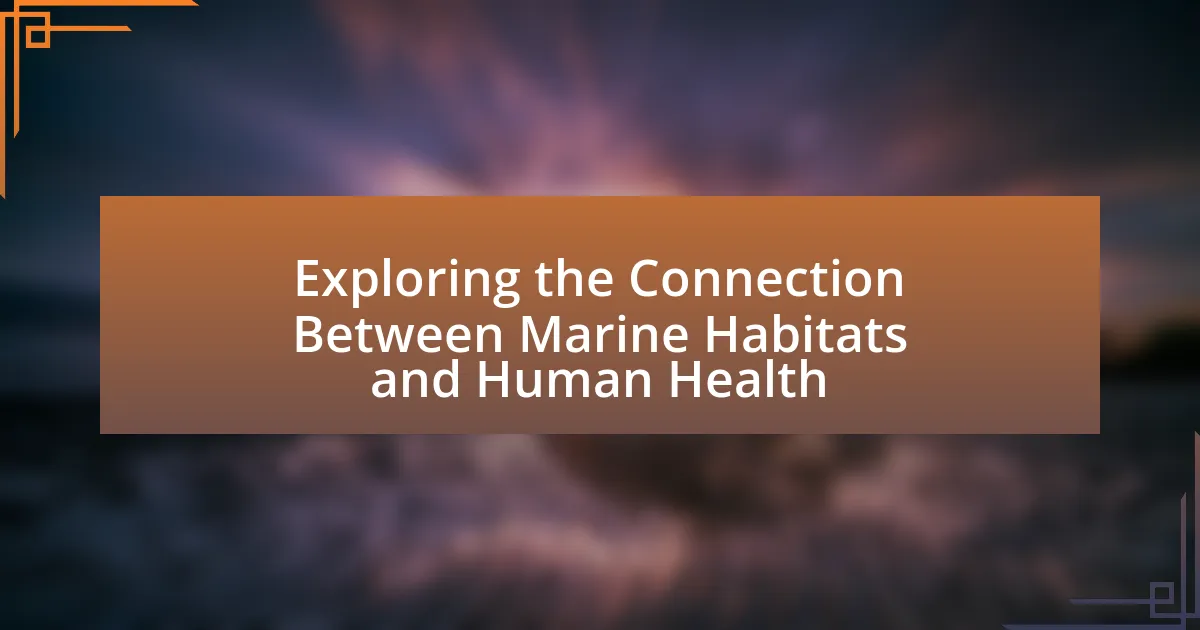The article explores the significant connection between marine habitats and human health, highlighting how ecosystems such as coral reefs, mangroves, and seagrass beds provide essential resources, support biodiversity, and contribute to mental well-being. It discusses the nutritional benefits of marine biodiversity, the role of these habitats in climate regulation, and their protective functions against natural disasters. Additionally, the article addresses the threats posed by pollution, overfishing, and climate change to marine ecosystems and their implications for human health, emphasizing the need for sustainable practices and conservation efforts to safeguard both marine environments and public health.

What is the connection between marine habitats and human health?
Marine habitats significantly influence human health through their role in providing food, regulating climate, and supporting biodiversity. Healthy marine ecosystems, such as coral reefs and mangroves, contribute to the availability of seafood, which is a primary source of protein and essential nutrients for billions of people globally. Additionally, marine environments help mitigate climate change by absorbing carbon dioxide, thus reducing the impact of climate-related health issues. Research indicates that coastal ecosystems can also protect against natural disasters, which in turn safeguards human populations from injury and displacement. Furthermore, exposure to marine environments has been linked to improved mental health and well-being, as evidenced by studies showing reduced stress levels and enhanced mood among individuals who engage in activities like swimming or beach visits.
How do marine habitats influence human well-being?
Marine habitats significantly influence human well-being by providing essential resources, ecosystem services, and recreational opportunities. These habitats, such as coral reefs and mangroves, support fisheries that supply food and livelihoods for millions of people globally; for instance, approximately 1 billion people rely on fish as their primary source of protein. Additionally, marine ecosystems contribute to coastal protection, reducing the impact of storms and erosion, which is vital for the safety and economic stability of coastal communities. Furthermore, marine environments offer recreational and mental health benefits, as activities like swimming, diving, and fishing promote physical health and psychological well-being. Studies have shown that access to natural environments, including marine habitats, is linked to lower stress levels and improved mental health outcomes.
What specific aspects of marine habitats contribute to health benefits?
Marine habitats contribute to health benefits through biodiversity, nutrient cycling, and stress reduction. Biodiversity in marine ecosystems, such as coral reefs and mangroves, supports a wide range of species that provide food, medicinal resources, and ecosystem services essential for human health. Nutrient cycling in these habitats enhances water quality and supports fisheries, which are vital for nutrition and economic stability. Additionally, exposure to marine environments has been shown to reduce stress and improve mental well-being, as evidenced by studies indicating that time spent near the ocean can lower cortisol levels and promote relaxation.
How do marine ecosystems support mental health and well-being?
Marine ecosystems support mental health and well-being by providing restorative environments that reduce stress and promote relaxation. Research indicates that exposure to natural marine settings can lower cortisol levels, which are associated with stress, and enhance mood through the presence of calming sounds and visuals. A study published in the journal “Health & Place” found that individuals living near coastal areas reported higher levels of life satisfaction and lower levels of anxiety compared to those in urban settings. Additionally, engaging in activities such as swimming, snorkeling, or simply walking along the beach has been shown to improve mental clarity and emotional resilience, further reinforcing the positive impact of marine environments on mental health.
Why is understanding this connection important?
Understanding the connection between marine habitats and human health is crucial because it highlights how the health of ocean ecosystems directly impacts human well-being. Healthy marine environments provide essential resources such as food, medicine, and recreational opportunities, which are vital for nutrition and mental health. For instance, studies show that communities relying on fisheries for their livelihoods experience better health outcomes when fish populations are sustainable, as indicated by the World Health Organization’s reports on nutrition and food security. Additionally, marine ecosystems contribute to climate regulation and pollution filtration, which further protect human health by reducing the risks of diseases associated with environmental degradation.
What are the implications for public health policies?
The implications for public health policies include the necessity to integrate marine ecosystem health into public health frameworks. Research indicates that healthy marine habitats contribute to food security, mental well-being, and disease prevention, highlighting the interconnectedness of environmental and human health. For instance, the World Health Organization emphasizes that marine biodiversity supports nutrition and livelihoods, which are critical for community health outcomes. Therefore, public health policies must prioritize the protection of marine environments to enhance overall public health and mitigate risks associated with marine degradation.
How can this knowledge inform conservation efforts?
Knowledge about the connection between marine habitats and human health can inform conservation efforts by highlighting the importance of preserving these ecosystems for both environmental and public health benefits. For instance, healthy marine environments contribute to clean water, which is essential for human health, and support biodiversity that can lead to the discovery of new medicines. Research indicates that coastal ecosystems, such as mangroves and coral reefs, provide critical services, including carbon sequestration and protection against natural disasters, which are vital for community resilience. By understanding these interdependencies, conservation strategies can prioritize the protection of marine habitats, ensuring sustainable resources for future generations while simultaneously safeguarding human health.

What are the key marine habitats relevant to human health?
Key marine habitats relevant to human health include coral reefs, mangroves, and seagrass beds. Coral reefs provide essential ecosystem services such as fish habitat and coastal protection, which are vital for food security and economic stability. Mangroves act as natural barriers against storm surges and erosion, while also supporting biodiversity and water quality. Seagrass beds contribute to carbon sequestration and serve as nurseries for various marine species, enhancing fisheries. These habitats collectively support human health by maintaining ecological balance and providing resources critical for nutrition and livelihood.
What types of marine habitats exist?
Various types of marine habitats exist, including coral reefs, mangroves, seagrass beds, estuaries, and open ocean. Coral reefs are biodiverse ecosystems that provide shelter and food for numerous marine species. Mangroves serve as critical coastal buffers and nurseries for fish. Seagrass beds are vital for carbon sequestration and support marine life. Estuaries, where freshwater meets saltwater, are productive environments that filter pollutants and provide habitat for various organisms. The open ocean, covering vast areas, is home to pelagic species and plays a significant role in global climate regulation. Each habitat type contributes uniquely to marine biodiversity and ecosystem services, underscoring their importance in maintaining ecological balance and supporting human health.
How do coral reefs contribute to human health?
Coral reefs contribute to human health by providing essential resources such as food, medicine, and coastal protection. These ecosystems support a diverse range of marine life, which is crucial for fisheries that supply protein to millions of people globally. Additionally, coral reefs are a source of bioactive compounds used in pharmaceuticals; for instance, compounds derived from coral reef organisms have been researched for their potential in cancer treatment and pain relief. Furthermore, healthy coral reefs protect coastlines from erosion and storm surges, reducing the risk of flooding and associated health hazards for coastal communities. Studies indicate that the loss of coral reefs could lead to increased health risks due to diminished food security and increased vulnerability to natural disasters.
What role do mangroves play in coastal health?
Mangroves play a crucial role in coastal health by providing essential ecosystem services that protect shorelines and support biodiversity. They act as natural barriers against storm surges and coastal erosion, reducing the impact of extreme weather events on coastal communities. Additionally, mangroves serve as habitats for various marine species, including fish and crustaceans, which are vital for local fisheries and food security. Studies indicate that mangrove ecosystems can sequester carbon at rates up to four times higher than terrestrial forests, contributing to climate change mitigation. Their complex root systems also filter pollutants from water, improving overall water quality in coastal areas.
How do these habitats provide resources for human health?
Marine habitats provide essential resources for human health through the supply of food, medicinal compounds, and ecosystem services. These habitats, such as coral reefs and mangroves, are rich in biodiversity, which contributes to the availability of fish and shellfish that are vital sources of protein and omega-3 fatty acids for human diets. Additionally, marine organisms produce bioactive compounds that are used in pharmaceuticals; for example, compounds derived from sea sponges and algae have been developed into cancer treatments and anti-inflammatory drugs. Furthermore, healthy marine ecosystems contribute to coastal protection, water purification, and carbon sequestration, which are crucial for maintaining environmental stability and reducing the impacts of climate change on human health.
What are the nutritional benefits of marine biodiversity?
Marine biodiversity provides essential nutritional benefits, including a rich source of proteins, omega-3 fatty acids, vitamins, and minerals. Fish and shellfish, which are key components of marine biodiversity, are high in essential nutrients that contribute to human health, such as vitamin D, iodine, and selenium. For instance, fatty fish like salmon and mackerel are particularly noted for their high omega-3 content, which is linked to reduced risks of heart disease and improved brain function. Additionally, marine plants, such as seaweed, offer dietary fiber and a variety of micronutrients, enhancing overall nutritional intake. Studies indicate that populations with diets rich in marine biodiversity experience lower rates of chronic diseases, underscoring the importance of these resources for human health.
How do marine habitats support medicinal resources?
Marine habitats support medicinal resources by providing a diverse array of organisms that produce bioactive compounds used in pharmaceuticals. For instance, marine organisms such as sponges, corals, and algae have been found to contain unique chemical substances that exhibit anti-cancer, anti-inflammatory, and anti-viral properties. Research has identified over 15,000 marine natural products, with many undergoing clinical trials for drug development, demonstrating the significant potential of marine biodiversity in contributing to human health.

What are the threats to marine habitats and their impact on human health?
Threats to marine habitats include pollution, overfishing, habitat destruction, climate change, and invasive species, all of which significantly impact human health. Pollution, such as plastic waste and toxic chemicals, contaminates seafood, leading to health issues like mercury poisoning in humans. Overfishing depletes fish populations, disrupting ecosystems and reducing food security, which can lead to malnutrition. Habitat destruction, such as coral reef degradation, diminishes biodiversity and the natural services these ecosystems provide, including coastal protection and water filtration, which are vital for human communities. Climate change causes ocean acidification and rising temperatures, affecting fish stocks and increasing the prevalence of harmful algal blooms, which can produce toxins harmful to human health. Invasive species can alter local ecosystems, leading to declines in native species that are crucial for maintaining ecological balance and human livelihoods.
What human activities threaten marine ecosystems?
Human activities that threaten marine ecosystems include overfishing, pollution, habitat destruction, and climate change. Overfishing depletes fish populations, disrupting food chains and leading to ecosystem imbalances; for instance, the collapse of cod stocks in the North Atlantic has had significant ecological repercussions. Pollution from plastics, chemicals, and agricultural runoff introduces toxins into marine environments, harming wildlife and degrading habitats; studies show that over 8 million tons of plastic enter oceans annually, affecting marine life. Habitat destruction, such as coastal development and bottom trawling, leads to loss of critical habitats like coral reefs and mangroves, which are essential for biodiversity and coastal protection. Climate change results in ocean acidification and rising temperatures, threatening species survival and altering marine ecosystems; research indicates that ocean temperatures have increased by approximately 1 degree Celsius since the late 19th century, impacting marine biodiversity.
How does pollution affect marine habitats and human health?
Pollution adversely affects marine habitats and human health by introducing harmful substances that disrupt ecosystems and contaminate food sources. Marine habitats suffer from reduced biodiversity, as pollutants like plastics, heavy metals, and chemicals lead to habitat degradation and species decline. For instance, a study published in the journal “Marine Pollution Bulletin” found that microplastics have been ingested by marine organisms, causing physical harm and toxicological effects, which can cascade through the food web.
Human health is impacted through the consumption of contaminated seafood, which can lead to various health issues, including neurological disorders and increased cancer risk. The World Health Organization reports that pollutants such as mercury and polychlorinated biphenyls (PCBs) can accumulate in fish, posing significant health risks to populations relying on seafood as a primary protein source. Thus, pollution creates a direct link between the health of marine ecosystems and human well-being.
What is the impact of climate change on marine ecosystems?
Climate change significantly impacts marine ecosystems by altering ocean temperatures, acidifying waters, and disrupting species distributions. Rising sea temperatures lead to coral bleaching, which affects biodiversity and the health of marine habitats. Ocean acidification, caused by increased carbon dioxide absorption, negatively impacts shellfish and other calcifying organisms, disrupting food webs. Additionally, shifting species distributions due to changing temperatures can result in the loss of local fisheries and affect human communities reliant on these resources. According to the Intergovernmental Panel on Climate Change (IPCC), these changes threaten the resilience of marine ecosystems and their ability to provide essential services to humans, such as food security and coastal protection.
How can we mitigate these threats to protect human health?
To mitigate threats to human health associated with marine habitats, implementing sustainable fishing practices is essential. Sustainable fishing reduces overfishing and habitat destruction, which can lead to the decline of marine biodiversity and the disruption of ecosystems that support human health. For instance, the Food and Agriculture Organization (FAO) reports that sustainable fisheries management can enhance fish stocks and ensure food security for millions of people who rely on fish as a primary protein source. Additionally, protecting marine environments through the establishment of marine protected areas (MPAs) can help preserve critical habitats, thereby maintaining ecosystem services such as water purification and carbon sequestration, which are vital for human health. Research published in the journal “Nature” indicates that MPAs can lead to increased fish populations and biodiversity, ultimately benefiting coastal communities.
What conservation strategies are effective for marine habitats?
Effective conservation strategies for marine habitats include the establishment of marine protected areas (MPAs), sustainable fishing practices, habitat restoration, and pollution reduction initiatives. Marine protected areas help preserve biodiversity by restricting human activities in critical ecosystems, as evidenced by studies showing that MPAs can lead to increased fish populations and healthier marine ecosystems. Sustainable fishing practices, such as catch limits and gear restrictions, ensure that fish stocks remain viable, with research indicating that well-managed fisheries can recover and thrive. Habitat restoration efforts, like coral reef rehabilitation, have been shown to enhance ecosystem resilience, while pollution reduction initiatives, including plastic waste management and nutrient runoff control, mitigate harmful impacts on marine life. These strategies collectively contribute to the health of marine habitats, which in turn supports human health through ecosystem services like food security and climate regulation.
How can individuals contribute to marine habitat preservation?
Individuals can contribute to marine habitat preservation by reducing plastic use and participating in clean-up efforts. By minimizing plastic consumption, individuals help decrease the amount of waste that enters oceans, which is a significant threat to marine life; studies show that over 8 million tons of plastic enter the ocean annually, harming ecosystems. Additionally, engaging in local beach clean-ups directly removes debris that can suffocate marine organisms and disrupt habitats, fostering healthier marine environments.
What practical steps can individuals take to enhance their health through marine habitats?
Individuals can enhance their health through marine habitats by engaging in activities such as swimming, snorkeling, or diving in clean ocean waters, which have been shown to improve physical fitness and mental well-being. Research indicates that exposure to marine environments can reduce stress levels and promote relaxation, as evidenced by a study published in the journal “Health & Place,” which found that individuals who spent time near the ocean reported lower levels of anxiety and depression. Additionally, consuming seafood from sustainable marine sources provides essential nutrients like omega-3 fatty acids, which are linked to improved cardiovascular health and cognitive function. Therefore, participating in marine activities and incorporating seafood into one’s diet are practical steps individuals can take to leverage the health benefits associated with marine habitats.
How can engaging with marine environments improve personal well-being?
Engaging with marine environments can significantly improve personal well-being by reducing stress and enhancing mental health. Studies indicate that exposure to natural settings, particularly coastal areas, leads to lower levels of cortisol, a stress hormone, and promotes feelings of relaxation and happiness. For instance, research published in the journal “Health & Place” found that individuals who spend time near the ocean report higher life satisfaction and lower anxiety levels. Additionally, activities such as swimming, snorkeling, or simply walking along the beach encourage physical exercise, which is linked to improved mood and overall health. Thus, interaction with marine environments fosters both psychological and physical benefits, contributing to enhanced personal well-being.
What are the best practices for sustainable interaction with marine ecosystems?
The best practices for sustainable interaction with marine ecosystems include reducing pollution, practicing responsible fishing, and supporting marine conservation efforts. Reducing pollution involves minimizing plastic waste and harmful chemicals entering the ocean, which can harm marine life and disrupt ecosystems. Responsible fishing practices, such as adhering to catch limits and using selective gear, help maintain fish populations and biodiversity. Supporting marine conservation efforts, such as establishing marine protected areas, ensures the preservation of critical habitats and species. According to the United Nations, sustainable fishing practices can help restore fish stocks to healthy levels, benefiting both marine ecosystems and human communities reliant on these resources.
